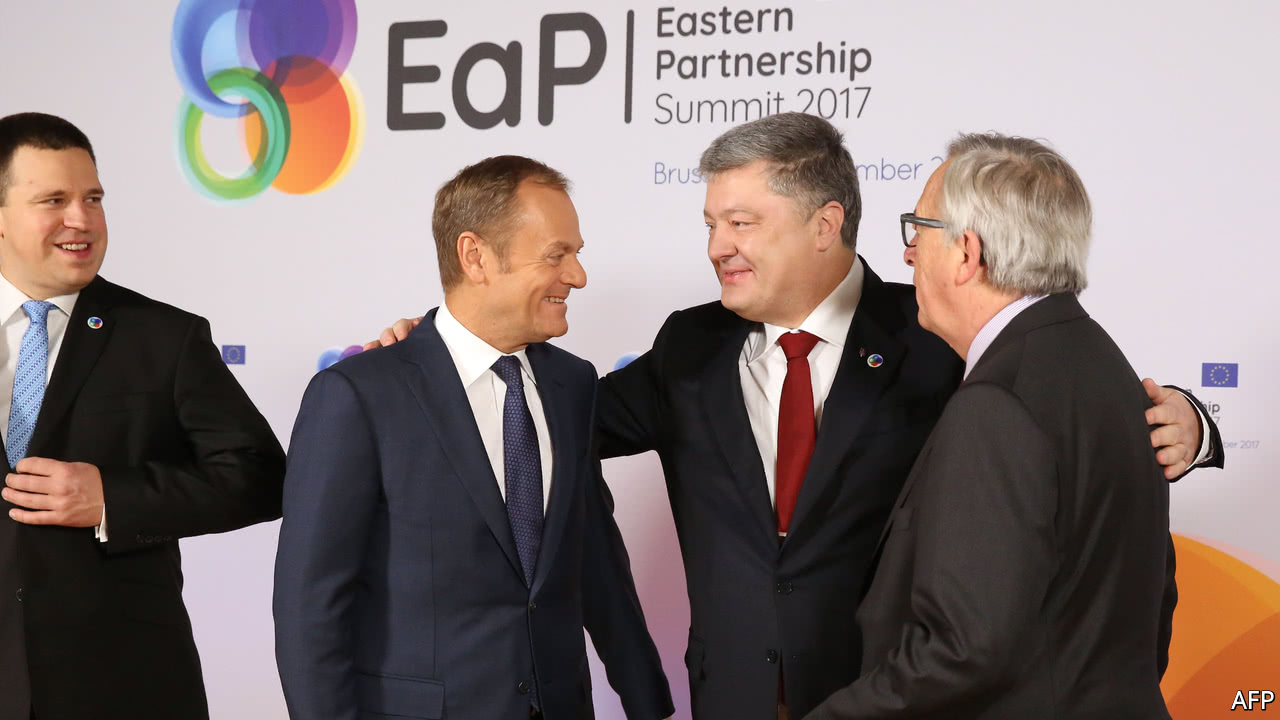by M.S.
 NO ONE has ever been quite sure where Europe ends and Asia starts. In the Middle Ages geographers drew the border along various rivers, including the Dnieper and the Volga. By the 1950s the Soviet Union settled on a line running down the Ural mountains, and along the ridge of the Caucasus between the Black and Caspian Seas. But this excludes Armenia, Azerbaijan and Georgia, which tend to think of themselves as European. It also includes a number of countries that the European Union is not ready to accept as candidates for membership. To address these countries’ aspirations, in 2009 the EU launched an initiative called the Eastern Partnership, which covers (in west-to-east order) Belarus, Ukraine, Moldova, Georgia, Armenia and Azerbaijan. On November 24th EU leaders held a summit with these partners in Brussels to discuss the Eastern Partnership.
NO ONE has ever been quite sure where Europe ends and Asia starts. In the Middle Ages geographers drew the border along various rivers, including the Dnieper and the Volga. By the 1950s the Soviet Union settled on a line running down the Ural mountains, and along the ridge of the Caucasus between the Black and Caspian Seas. But this excludes Armenia, Azerbaijan and Georgia, which tend to think of themselves as European. It also includes a number of countries that the European Union is not ready to accept as candidates for membership. To address these countries’ aspirations, in 2009 the EU launched an initiative called the Eastern Partnership, which covers (in west-to-east order) Belarus, Ukraine, Moldova, Georgia, Armenia and Azerbaijan. On November 24th EU leaders held a summit with these partners in Brussels to discuss the Eastern Partnership.
The partnership’s purpose is to increase both economic and governmental compatibility and co-operation with the EU’s eastern neighbours. On the governmental side, it includes a host of initiatives to improve democratic governance, enhance the independence of the judiciary, bolster civil-society groups and reduce corruption. On the economic side, it sets up programmes to bring eastern countries’ labour rules and food- and product-safety standards in line with EU ones, and to ease trade barriers. The aim is to implement what the EU refers to as AA/DCFTAs, or Association Agreements and Deep and Comprehensive Free Trade Areas. So far these have been signed with Georgia, Moldova and Ukraine (whose president, Petro Poroshenko, is pictured above, middle, with Donald Tusk, the president of the European Council, and Jean-Claude Juncker, the president of the European Commission Jean-Claude Juncker). At the summit the partners promised to reach 20 new targets by 2020, in areas like transport links and energy efficiency.
Most Eastern Partnership countries see this as a prelude to eventual candidacy for EU membership. But the EU’s current members are wary. With the exception of Georgia, the Eastern Partnership countries are all too corrupt to qualify for membership, and are ranked in the lower half of the World Bank’s control-of-corruption index. Belarus and Azerbaijan are autocracies whose elections are shams; in Ukraine and Moldova, the political system is dominated by wealthy oligarchs. Russian troops occupy parts of the territories of Georgia, Moldova and Ukraine. Armenia, Azerbaijan and Belarus are military allies of Russia, to a greater or lesser extent. Azerbaijan and Armenia have been at war with each other for decades.
As a result many EU members are leery of allowing things to move on to the accession stage, even for the three countries that have signed AA/DCFTAs. The EU’s north-western members were wrong-footed by the unexpected numbers of Poles, Romanians and Bulgarians who moved west after their countries joined between 2004 and 2007, and want to avoid repeating the experience. The Netherlands is especially reluctant. In 2016 it negotiated changes to the EU’s association agreement with Ukraine, after Dutch voters rejected the original version in a referendum. Dutch diplomats have pushed to drop talk of the eastern partners’ “European aspirations”. At the summit on November 24th, they seem to have lost out: as in the previous summit in 2015, the final document says the EU members “acknowledge the European aspirations and European choice of the partners”. Whether “acknowledge” will ever translate into “accept” is another question.
No comments:
Post a Comment